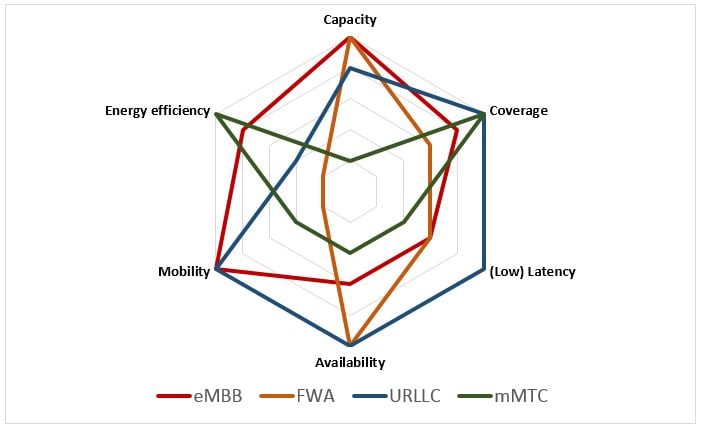In our previous post, we crowed the 5G network as the bearer of the ultimate mobile experience – the Enhanced Mobile Broadband (eMBB).
But is that what 5G is all about?
The answer is – no!
5G actually brings four game-changing concepts that allow mobile operators, ISPs, CLECs and other service providers to significantly grow their business, address new markets and provide new and revolutionary services.
The four game changers
- Enhanced Mobile Broadband (eMBB). The next generation mobile experience
- Massive Machine-Type Communication (mMTC). For massive Internet of Things (IoT) and Machine to Machine (M2M) applications
- Ultra-Reliable Low-Latency Communication (URLLC). For mission-critical applications.
- Fixed Wireless Access (FWA). For fixed broadband applications
Those four applications differ in both the target market and the technology and infrastructure requirements.
In the target markets, eMBB and FWA address an existing audience, namely mobile users and fixed subscribers. These existing markets are offered a new service in the case of eMBB (for example, virtual reality and augmented reality) or a cost-effective alternative to an existing service in the case of FWA. In this case, 5G becomes an alternative to fixed broadband technologies such as Fiber to the Home (FTTH), which is far more cost-efficient.
The two other applications, mMTC and URLLC, open up new addressable markets for service providers who can now address non-human end-customers. IoT and M2M applications such as Automated Meter Reading (AMR), and sensor-based agriculture or smart bins were served (where applicable) by proprietary networks until today and can now be served by a unified 5G network instead.
Mission-critical applications such as Vehicle to Anything (V2X), tactile internet and safe city, also open up additional markets to service providers by utilizing the 5G infrastructure to accommodate multiple scenarios.
While 5G RAN and 5G backhaul are common to these four use cases, both of them need to accommodate the different requirements of each of the use cases.
Comparison of eMBB and mMTC
To emphasize the wide scope of requirements, let’s compare the eMBB and mMTC use cases.
eMBB aims to provide the highest capacity and requires network densification to effectively cover hot-spots in urban areas.
On the other end of the scope, some IoT applications such as smart agriculture require coverage of not-spots (areas that were not covered by a mobile service in the past), which means network expansion but requires very low bandwidth and highly efficient power control.
URLLC adds strict requirements for end-to-end latency as well as high availability. Both are not an issue when it comes to mMTC and eMBB while FWA combines the need for high capacity with a requirement for high availability.
The following diagram illustrates the different requirements of each application:

The illustrated differences between the different applications affect all parts of the network infrastructure.
In cases where a service provider seeks to extend its service offering and its addressable market by providing a combination of these services, it must build its network to support the requirements of the services it intends to provide. 5G RAN, 5G backhaul, together with the network architecture and its core elements, must all support the required capacity, availability, coverage and latency related to the provided services.
Download this infographic to learn more about 5G RAN and 5G backhaul technologies, which are essential to supporting these services.

%20the%20ultimate%20mobile%20experience.jpg?width=780&height=408&name=5G%20%E2%80%93%20(not%20only)%20the%20ultimate%20mobile%20experience.jpg)